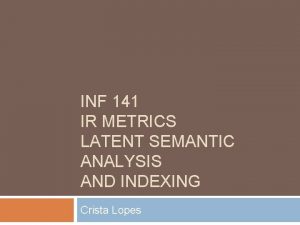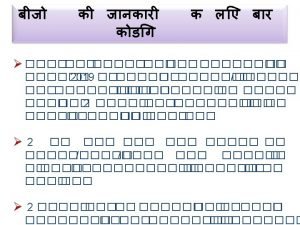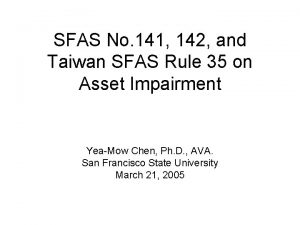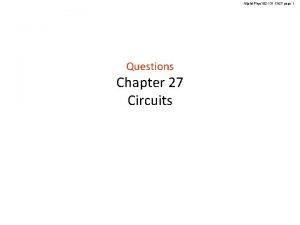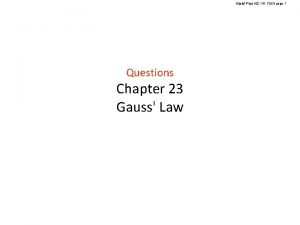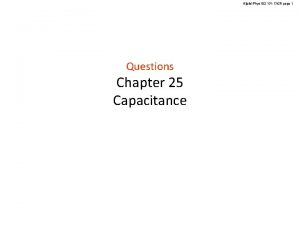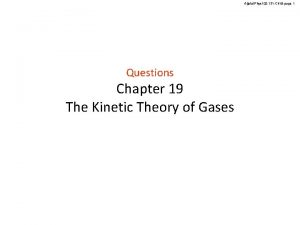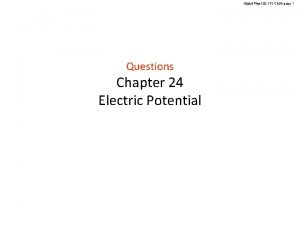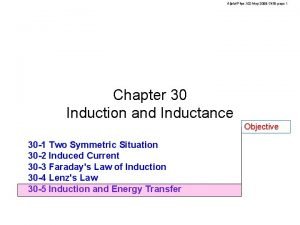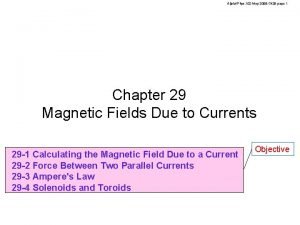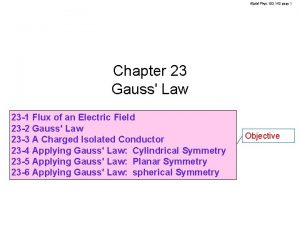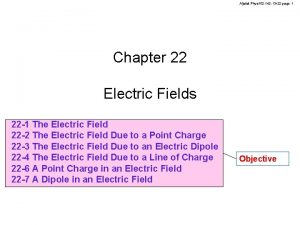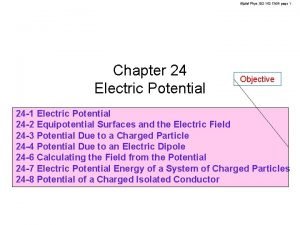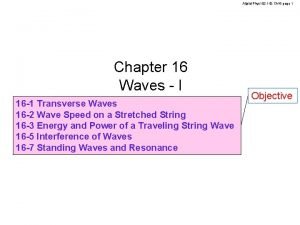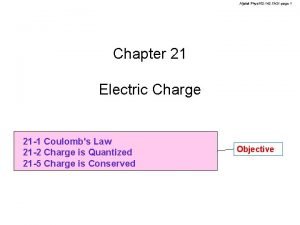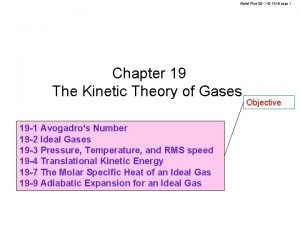AljalalPhys 102 141 page 1 Questions Chapter 16















- Slides: 15

Aljalal-Phys 102 -141 -page 1 Questions Chapter 16 Waves - I

16 -4 Wavelength and Frequency Aljalal-Phys 102 -141 -page 2 The displacement of a string carrying a traveling sinusoidal wave is given by: y (x , t ) = ym sin(kx − ω t + ϕ ). At time t = 0 the point at x = 0 has a displacement of zero and is moving in the positive y direction. Find the value of the phase constant φ. A) 180 degrees B) 90 degrees C) 135 degrees D) 0 degrees E) 270 degrees Answer A

Aljalal-Phys 102 -141 -page 3 16 -4 Wavelength and Frequency M 1 -081 u An element of the string moves transversely in a harmonic manner. Constant Wave speed v

16 -5 The Speed of a Traveling Wave Aljalal-Phys 102 -141 -page 4 A transverse sinusoidal wave is travelling on a stretched string. The maximum transverse speed of a particle on the string is 24. 0 m/s. The frequency of oscillations of a particle in the string is 120 Hz. What is the amplitude of the wave? A) 43. 3 mm B) 25. 1 mm C) 12. 0 mm D) 31. 8 mm E) 53. 2 mm Answer D

16 -5 The Speed of a Traveling Wave Aljalal-Phys 102 -141 -page 5

16 -6 Wave Speed on a Stretched String Aljalal-Phys 102 -141 -page 6 A stretched string of mass 2. 0 g and length 10 cm, carries a wave having the following displacement wave: y (x, t ) = 0. 05 sin(2π x − 400π t ) , where x and y are in meters and t is in seconds. What is the tension in the string? A) 55 N B) 150 N C) 800 N D) 15 N E) 100 N Answer C

16 -6 Wave Speed on a Stretched String Aljalal-Phys 102 -141 -page 7 Answer C

16 -7 Energy and Power of a Traveling String Wave Aljalal-Phys 102 -141 -page 8 A harmonic wave in a string is described by the equation: y(x, t) = 0. 200 sin(π x − 40. 0 t) , where x and y are in m and t in s. If the mass per unit length of this string is 15. 0 g/m, determine the power transmitted to the wave. A) 0 W B) 14. 6 W C) 9. 80 W D) 73. 5 W E) 6. 11 W Answer E

16 -7 Energy and Power of a Traveling String Wave Aljalal-Phys 102 -141 -page 9

16 -9 Interference of Waves Aljalal-Phys 102 -141 -page 10 Two identical traveling waves of amplitude 10. 0 cm, moving in the same direction, are out of phase by π/4 rad. Find the amplitude of the resultant wave. A) 0. 800 cm B) 18. 5 cm C) 1. 20 cm D) 0. 400 cm E) 2. 40 cm Answer B

16 -9 Interference of Waves Amplitude Aljalal-Phys 102 -141 -page 11

16 -10 Standing Waves Aljalal-Phys 102 -141 -page 12 A stretched string that is fixed at both ends oscillates in a third-harmonic standing wave pattern. The distance between two adjacent nodes is 0. 75 m. The tension is varied until the fourth-harmonic standing wave is generated on the same string. What is the distance between two adjacent nodes in this case? A) 1. 0 m B) 0. 56 m C) 3. 0 m D) 0. 38 m E) 1. 5 m Answer B

16 -10 Standing Waves Aljalal-Phys 102 -141 -page 13 Wave 1 + Wave 2 Superposition principle = Resultant wave A standing wave

16 -10 Standing Waves Aljalal-Phys 102 -141 -page 14 Standing waves are produced by the interference of two traveling sinusoidal waves, each of frequency 100 Hz. The distance from the 2 nd node to the 5 th node is 60 cm. The wavelength of each of the two original waves is: A) 30 cm B) 50 cm C) 15 cm D) 20 cm E) 40 cm Answer E

16 -10 Standing Waves Aljalal-Phys 102 -141 -page 15


